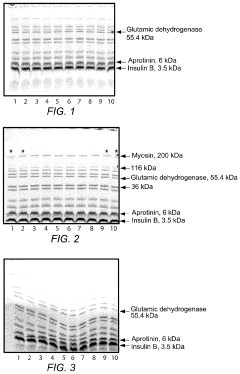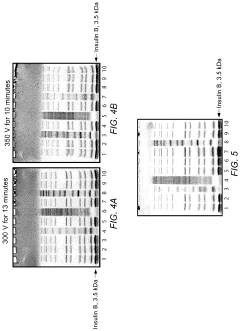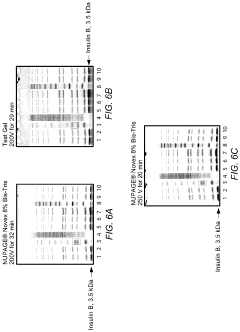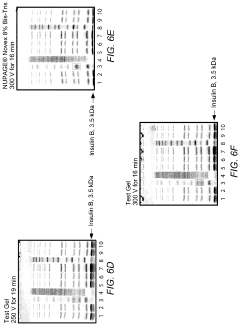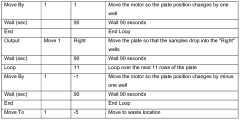Gel Electrophoresis for High-Throughput Genetic Screening
JUL 1, 20259 MIN READ
Generate Your Research Report Instantly with AI Agent
Patsnap Eureka helps you evaluate technical feasibility & market potential.
Genetic Screening Evolution and Objectives
Genetic screening has undergone a remarkable evolution since its inception in the mid-20th century. Initially focused on identifying single-gene disorders, the field has expanded to encompass a wide range of genetic variations and their potential impacts on health and disease. The advent of gel electrophoresis in the 1970s marked a significant milestone, enabling researchers to separate and analyze DNA fragments based on their size and charge.
As technology advanced, the objectives of genetic screening have broadened considerably. From prenatal testing for chromosomal abnormalities to newborn screening for metabolic disorders, the applications have grown exponentially. The Human Genome Project, completed in 2003, further accelerated the field by providing a comprehensive map of human DNA, opening new avenues for understanding genetic diversity and disease susceptibility.
In recent years, the focus has shifted towards high-throughput genetic screening, driven by the need for faster, more efficient, and cost-effective methods to analyze large populations. This shift has been propelled by advancements in DNA sequencing technologies, bioinformatics, and automation. The ultimate goal is to enable personalized medicine, where genetic information can guide tailored prevention strategies and treatment plans for individuals.
Gel electrophoresis, while a foundational technique, has faced limitations in meeting the demands of high-throughput screening. Traditional gel-based methods are time-consuming, labor-intensive, and have limited resolution for complex genetic analyses. However, innovations in gel electrophoresis techniques, such as pulsed-field gel electrophoresis and capillary electrophoresis, have aimed to address these challenges and maintain relevance in the era of high-throughput screening.
The objectives of modern genetic screening using gel electrophoresis for high-throughput applications are multifaceted. Researchers and clinicians aim to develop methods that can rapidly and accurately analyze multiple genetic markers simultaneously, process large sample volumes efficiently, and integrate seamlessly with downstream analysis tools. Additionally, there is a push to miniaturize and automate gel electrophoresis systems to reduce costs, increase throughput, and minimize human error.
As we look to the future, the goals of genetic screening continue to evolve. There is a growing emphasis on developing non-invasive screening methods, improving the interpretation of complex genetic data, and addressing ethical considerations surrounding genetic information. The integration of gel electrophoresis with emerging technologies like microfluidics and artificial intelligence promises to further enhance its capabilities in high-throughput genetic screening, contributing to the broader objectives of precision medicine and population health management.
As technology advanced, the objectives of genetic screening have broadened considerably. From prenatal testing for chromosomal abnormalities to newborn screening for metabolic disorders, the applications have grown exponentially. The Human Genome Project, completed in 2003, further accelerated the field by providing a comprehensive map of human DNA, opening new avenues for understanding genetic diversity and disease susceptibility.
In recent years, the focus has shifted towards high-throughput genetic screening, driven by the need for faster, more efficient, and cost-effective methods to analyze large populations. This shift has been propelled by advancements in DNA sequencing technologies, bioinformatics, and automation. The ultimate goal is to enable personalized medicine, where genetic information can guide tailored prevention strategies and treatment plans for individuals.
Gel electrophoresis, while a foundational technique, has faced limitations in meeting the demands of high-throughput screening. Traditional gel-based methods are time-consuming, labor-intensive, and have limited resolution for complex genetic analyses. However, innovations in gel electrophoresis techniques, such as pulsed-field gel electrophoresis and capillary electrophoresis, have aimed to address these challenges and maintain relevance in the era of high-throughput screening.
The objectives of modern genetic screening using gel electrophoresis for high-throughput applications are multifaceted. Researchers and clinicians aim to develop methods that can rapidly and accurately analyze multiple genetic markers simultaneously, process large sample volumes efficiently, and integrate seamlessly with downstream analysis tools. Additionally, there is a push to miniaturize and automate gel electrophoresis systems to reduce costs, increase throughput, and minimize human error.
As we look to the future, the goals of genetic screening continue to evolve. There is a growing emphasis on developing non-invasive screening methods, improving the interpretation of complex genetic data, and addressing ethical considerations surrounding genetic information. The integration of gel electrophoresis with emerging technologies like microfluidics and artificial intelligence promises to further enhance its capabilities in high-throughput genetic screening, contributing to the broader objectives of precision medicine and population health management.
Market Analysis for High-Throughput Genetic Testing
The high-throughput genetic testing market has experienced significant growth in recent years, driven by advancements in technology, increasing awareness of genetic disorders, and the growing demand for personalized medicine. This market segment is expected to continue its upward trajectory, with a compound annual growth rate (CAGR) projected to exceed 10% over the next five years.
The primary drivers of market demand include the rising prevalence of genetic disorders, growing adoption of precision medicine, and increasing applications in oncology and prenatal testing. Healthcare providers and research institutions are increasingly incorporating high-throughput genetic testing into their diagnostic and research protocols, recognizing its potential to improve patient outcomes and accelerate scientific discoveries.
Geographically, North America currently dominates the market, accounting for the largest share of global revenue. This is attributed to well-established healthcare infrastructure, high healthcare expenditure, and early adoption of advanced technologies. However, the Asia-Pacific region is expected to witness the fastest growth, driven by improving healthcare systems, increasing disposable income, and growing awareness of genetic testing benefits.
The market is segmented by technology, application, and end-user. Next-generation sequencing (NGS) technology holds the largest market share due to its ability to process large volumes of genetic data quickly and cost-effectively. In terms of applications, oncology testing represents the largest segment, followed by reproductive health and rare disease diagnosis.
Key end-users of high-throughput genetic testing include hospitals, diagnostic laboratories, and academic research institutions. The increasing integration of genetic testing into clinical practice is expected to drive demand from hospitals and diagnostic centers, while research institutions continue to utilize these technologies for large-scale genomic studies.
Despite the positive outlook, several factors may impact market growth. These include high costs associated with advanced genetic testing equipment, concerns about data privacy and security, and the need for skilled professionals to interpret complex genetic data. Additionally, regulatory challenges and reimbursement issues in some regions may slow market penetration.
Emerging trends shaping the market include the integration of artificial intelligence and machine learning for data analysis, the development of portable and point-of-care testing devices, and the increasing focus on direct-to-consumer genetic testing services. These innovations are expected to expand the accessibility and applications of high-throughput genetic testing, further driving market growth in the coming years.
The primary drivers of market demand include the rising prevalence of genetic disorders, growing adoption of precision medicine, and increasing applications in oncology and prenatal testing. Healthcare providers and research institutions are increasingly incorporating high-throughput genetic testing into their diagnostic and research protocols, recognizing its potential to improve patient outcomes and accelerate scientific discoveries.
Geographically, North America currently dominates the market, accounting for the largest share of global revenue. This is attributed to well-established healthcare infrastructure, high healthcare expenditure, and early adoption of advanced technologies. However, the Asia-Pacific region is expected to witness the fastest growth, driven by improving healthcare systems, increasing disposable income, and growing awareness of genetic testing benefits.
The market is segmented by technology, application, and end-user. Next-generation sequencing (NGS) technology holds the largest market share due to its ability to process large volumes of genetic data quickly and cost-effectively. In terms of applications, oncology testing represents the largest segment, followed by reproductive health and rare disease diagnosis.
Key end-users of high-throughput genetic testing include hospitals, diagnostic laboratories, and academic research institutions. The increasing integration of genetic testing into clinical practice is expected to drive demand from hospitals and diagnostic centers, while research institutions continue to utilize these technologies for large-scale genomic studies.
Despite the positive outlook, several factors may impact market growth. These include high costs associated with advanced genetic testing equipment, concerns about data privacy and security, and the need for skilled professionals to interpret complex genetic data. Additionally, regulatory challenges and reimbursement issues in some regions may slow market penetration.
Emerging trends shaping the market include the integration of artificial intelligence and machine learning for data analysis, the development of portable and point-of-care testing devices, and the increasing focus on direct-to-consumer genetic testing services. These innovations are expected to expand the accessibility and applications of high-throughput genetic testing, further driving market growth in the coming years.
Gel Electrophoresis Challenges in High-Throughput Screening
Gel electrophoresis has been a cornerstone technique in genetic analysis for decades, but its application in high-throughput genetic screening presents several significant challenges. The primary obstacle lies in the inherent limitations of traditional gel electrophoresis methods when scaled up to meet the demands of high-throughput operations.
One of the most pressing issues is the time-consuming nature of gel preparation and sample loading. In high-throughput environments, where thousands of samples may need to be processed daily, the manual preparation of gels and individual sample loading becomes a major bottleneck. This not only reduces overall efficiency but also increases the likelihood of human error, potentially compromising the reliability of results.
Another challenge is the limited resolution and sensitivity of conventional gel electrophoresis techniques when dealing with complex genetic samples. As genetic screening becomes more sophisticated, requiring the detection of subtle genetic variations or low-abundance targets, traditional gel methods may struggle to provide the necessary level of discrimination.
The issue of reproducibility also becomes more pronounced in high-throughput settings. Variations in gel composition, running conditions, and imaging techniques can lead to inconsistencies between batches, making it difficult to compare results across large sample sets or between different laboratories.
Automation presents another hurdle. While robotic systems for sample handling and gel loading have been developed, integrating these with the gel electrophoresis process in a seamless, high-throughput workflow remains challenging. The physical nature of gel-based separations often requires human intervention at various stages, limiting the potential for full automation.
Data analysis and interpretation pose significant challenges in high-throughput genetic screening using gel electrophoresis. The large volume of image data generated requires sophisticated software solutions for automated band detection, quantification, and result interpretation. Developing robust algorithms that can accurately process diverse gel images while accounting for variations in gel quality and running conditions is an ongoing challenge.
Environmental concerns and waste management also become more significant at high-throughput scales. The increased consumption of reagents, particularly toxic ones like ethidium bromide, and the generation of large volumes of gel waste raise important sustainability and safety issues that need to be addressed.
Lastly, the integration of gel electrophoresis results with other high-throughput genetic screening techniques and bioinformatics pipelines presents a challenge. Ensuring seamless data flow and compatibility between different analytical platforms is crucial for comprehensive genetic analysis but requires careful consideration of data formats, storage, and processing capabilities.
One of the most pressing issues is the time-consuming nature of gel preparation and sample loading. In high-throughput environments, where thousands of samples may need to be processed daily, the manual preparation of gels and individual sample loading becomes a major bottleneck. This not only reduces overall efficiency but also increases the likelihood of human error, potentially compromising the reliability of results.
Another challenge is the limited resolution and sensitivity of conventional gel electrophoresis techniques when dealing with complex genetic samples. As genetic screening becomes more sophisticated, requiring the detection of subtle genetic variations or low-abundance targets, traditional gel methods may struggle to provide the necessary level of discrimination.
The issue of reproducibility also becomes more pronounced in high-throughput settings. Variations in gel composition, running conditions, and imaging techniques can lead to inconsistencies between batches, making it difficult to compare results across large sample sets or between different laboratories.
Automation presents another hurdle. While robotic systems for sample handling and gel loading have been developed, integrating these with the gel electrophoresis process in a seamless, high-throughput workflow remains challenging. The physical nature of gel-based separations often requires human intervention at various stages, limiting the potential for full automation.
Data analysis and interpretation pose significant challenges in high-throughput genetic screening using gel electrophoresis. The large volume of image data generated requires sophisticated software solutions for automated band detection, quantification, and result interpretation. Developing robust algorithms that can accurately process diverse gel images while accounting for variations in gel quality and running conditions is an ongoing challenge.
Environmental concerns and waste management also become more significant at high-throughput scales. The increased consumption of reagents, particularly toxic ones like ethidium bromide, and the generation of large volumes of gel waste raise important sustainability and safety issues that need to be addressed.
Lastly, the integration of gel electrophoresis results with other high-throughput genetic screening techniques and bioinformatics pipelines presents a challenge. Ensuring seamless data flow and compatibility between different analytical platforms is crucial for comprehensive genetic analysis but requires careful consideration of data formats, storage, and processing capabilities.
Current High-Throughput Gel Electrophoresis Methods
01 High-throughput gel electrophoresis systems
Advanced systems have been developed to increase the throughput of gel electrophoresis. These systems often incorporate multiple lanes, automated sample loading, and parallel processing capabilities. They may also include integrated imaging and analysis tools to speed up the overall process and handle a larger number of samples simultaneously.- High-throughput gel electrophoresis systems: Advanced systems have been developed to increase the throughput of gel electrophoresis. These systems often incorporate multiple lanes, automated sample loading, and parallel processing capabilities. They may also feature integrated imaging and analysis tools to speed up result interpretation.
- Microfluidic devices for gel electrophoresis: Microfluidic devices have been designed to miniaturize and accelerate gel electrophoresis processes. These devices often use microchannels and integrated electrodes to perform separations on a smaller scale, allowing for faster analysis times and reduced sample volumes.
- Multi-dimensional gel electrophoresis techniques: Two-dimensional and multi-dimensional gel electrophoresis techniques have been developed to improve separation resolution and increase the amount of information obtained from a single run. These methods often combine different separation principles, such as isoelectric focusing followed by size-based separation, to achieve higher throughput and better protein characterization.
- Automated gel electrophoresis systems: Automation has been introduced to various stages of the gel electrophoresis process, including sample preparation, loading, running, and analysis. These automated systems can significantly increase throughput by reducing manual interventions and standardizing procedures across multiple samples.
- Novel gel materials and compositions: Research has focused on developing new gel materials and compositions to enhance separation efficiency and speed. These innovations include temperature-responsive gels, gradient gels, and composite materials that can improve resolution and reduce run times, thereby increasing overall throughput.
02 Microfluidic devices for gel electrophoresis
Microfluidic devices have been designed to miniaturize and accelerate gel electrophoresis processes. These devices often use microchannels and integrated electrodes to perform electrophoresis on a smaller scale, allowing for faster separation times and reduced sample volumes. Some designs incorporate multiple parallel channels to increase throughput.Expand Specific Solutions03 Automated sample preparation and loading
Automation of sample preparation and loading processes has been developed to improve gel electrophoresis throughput. These systems may include robotic sample handling, automated buffer preparation, and precise sample injection mechanisms. By reducing manual intervention, these innovations can significantly increase the number of samples processed in a given time.Expand Specific Solutions04 Multi-dimensional gel electrophoresis techniques
Multi-dimensional gel electrophoresis techniques have been developed to enhance separation resolution and increase throughput. These methods often combine different separation principles, such as isoelectric focusing followed by size-based separation, to achieve better resolution of complex samples. Some approaches use specialized gel matrices or buffer systems to optimize separation efficiency.Expand Specific Solutions05 Real-time monitoring and analysis systems
Integration of real-time monitoring and analysis systems with gel electrophoresis has been implemented to improve throughput. These systems may include in-situ imaging, fluorescence detection, or other spectroscopic techniques to track the progress of separation in real-time. Advanced software algorithms are often employed for rapid data analysis and interpretation, reducing the overall time required for experiments.Expand Specific Solutions
Key Players in Genetic Screening Technology
The gel electrophoresis market for high-throughput genetic screening is in a growth phase, driven by increasing demand for genetic testing and personalized medicine. The global market size is estimated to be in the billions, with steady expansion projected. Technologically, the field is advancing rapidly, with companies like Life Technologies Corp. and Applied Biosystems LLC leading innovation in automated systems and high-throughput platforms. Established players such as Beckman Coulter and 3M are also contributing to technological maturity. However, emerging companies like Natera and EXACT Sciences are introducing novel applications, indicating ongoing innovation potential. The competitive landscape is characterized by a mix of large diversified corporations and specialized biotech firms, suggesting a dynamic and evolving market.
Life Technologies Corp.
Technical Solution: Life Technologies has developed advanced gel electrophoresis systems for high-throughput genetic screening. Their E-Gel™ system utilizes pre-cast agarose gels with integrated electrodes, allowing for rapid and efficient DNA separation[1]. The company's automated platforms, such as the E-Gel™ Power Snap Electrophoresis System, can process up to 96 samples simultaneously, significantly increasing throughput[2]. They have also introduced fluorescent DNA stains like SYBR™ Safe, which are less toxic and more sensitive than traditional ethidium bromide[3], enhancing both safety and detection capabilities in genetic screening applications.
Strengths: High-throughput capability, automated systems, and safer DNA staining methods. Weaknesses: Reliance on proprietary consumables may increase operational costs for users.
Beckman Coulter, Inc.
Technical Solution: Beckman Coulter has innovated in the field of gel electrophoresis with their GenomeLab™ GeXP Genetic Analysis System. This platform combines capillary electrophoresis with multiplexed PCR, allowing for simultaneous analysis of up to 35 genes in a single reaction[4]. Their system utilizes a patented dye chemistry and advanced software algorithms to achieve high sensitivity and specificity in genetic screening[5]. Additionally, Beckman Coulter has developed automated liquid handling systems that integrate seamlessly with their electrophoresis platforms, streamlining sample preparation and increasing overall throughput in genetic screening workflows[6].
Strengths: Multiplexed gene analysis, high sensitivity, and integrated automation. Weaknesses: Complex system may require specialized training for operation and maintenance.
Innovative Approaches in Gel-Based Genetic Screening
System for rapid high-resolution GEL electrophoresis
PatentActiveUS20190391113A1
Innovation
- The development of electrophoretic systems and formulations that allow for higher field strengths up to 50% more than conventional systems, using a discontinuous buffer system with specific gel amine and ampholyte buffers, and a pH range of 5.5 to 7.5, enabling faster separation of proteins within 30 minutes or less, even at higher voltages.
High throughput biomolecule separation and analysis
PatentWO2010078601A1
Innovation
- A multi-channel gel electrophoresis apparatus that uses multiple short linear gels for high-resolution separation and continuous, parallel fraction collection, employing fluid dynamics, electromotive forces, and gravity to enhance efficiency and speed of protein elution into collecting wells, allowing for high-throughput analysis without affinity tags.
Regulatory Framework for Genetic Screening Technologies
The regulatory framework for genetic screening technologies, particularly those involving gel electrophoresis for high-throughput applications, is a complex and evolving landscape. At the international level, organizations such as the World Health Organization (WHO) and the United Nations Educational, Scientific and Cultural Organization (UNESCO) have established guidelines and declarations that address the ethical and legal implications of genetic testing.
In the United States, the regulatory oversight of genetic screening technologies falls primarily under the purview of the Food and Drug Administration (FDA) and the Centers for Medicare & Medicaid Services (CMS). The FDA regulates genetic tests as medical devices, with different levels of scrutiny depending on the test's intended use and risk profile. High-throughput genetic screening methods using gel electrophoresis are typically classified as in vitro diagnostic devices (IVDs) and may require premarket approval or 510(k) clearance.
The Clinical Laboratory Improvement Amendments (CLIA) of 1988, administered by CMS, sets standards for laboratory testing to ensure the accuracy, reliability, and timeliness of patient test results. Laboratories performing high-throughput genetic screening must be CLIA-certified and adhere to stringent quality control measures.
In Europe, the regulatory landscape is governed by the In Vitro Diagnostic Regulation (IVDR), which came into full effect in May 2022. This regulation introduces a new risk-based classification system for IVDs, including genetic tests, and imposes stricter requirements for clinical evidence, post-market surveillance, and traceability.
Privacy and data protection regulations also play a crucial role in the genetic screening regulatory framework. In the United States, the Genetic Information Nondiscrimination Act (GINA) prohibits discrimination based on genetic information in health insurance and employment. The Health Insurance Portability and Accountability Act (HIPAA) provides additional protections for genetic information as part of an individual's health data.
The European Union's General Data Protection Regulation (GDPR) has far-reaching implications for genetic data handling, classifying genetic information as a special category of personal data subject to enhanced protection measures. This regulation impacts not only EU-based entities but also international organizations processing data of EU residents.
As the field of high-throughput genetic screening continues to advance, regulatory bodies are working to keep pace with technological developments. Emerging areas of focus include the regulation of direct-to-consumer genetic testing, the use of artificial intelligence in genetic data analysis, and the ethical considerations surrounding gene editing technologies like CRISPR.
In the United States, the regulatory oversight of genetic screening technologies falls primarily under the purview of the Food and Drug Administration (FDA) and the Centers for Medicare & Medicaid Services (CMS). The FDA regulates genetic tests as medical devices, with different levels of scrutiny depending on the test's intended use and risk profile. High-throughput genetic screening methods using gel electrophoresis are typically classified as in vitro diagnostic devices (IVDs) and may require premarket approval or 510(k) clearance.
The Clinical Laboratory Improvement Amendments (CLIA) of 1988, administered by CMS, sets standards for laboratory testing to ensure the accuracy, reliability, and timeliness of patient test results. Laboratories performing high-throughput genetic screening must be CLIA-certified and adhere to stringent quality control measures.
In Europe, the regulatory landscape is governed by the In Vitro Diagnostic Regulation (IVDR), which came into full effect in May 2022. This regulation introduces a new risk-based classification system for IVDs, including genetic tests, and imposes stricter requirements for clinical evidence, post-market surveillance, and traceability.
Privacy and data protection regulations also play a crucial role in the genetic screening regulatory framework. In the United States, the Genetic Information Nondiscrimination Act (GINA) prohibits discrimination based on genetic information in health insurance and employment. The Health Insurance Portability and Accountability Act (HIPAA) provides additional protections for genetic information as part of an individual's health data.
The European Union's General Data Protection Regulation (GDPR) has far-reaching implications for genetic data handling, classifying genetic information as a special category of personal data subject to enhanced protection measures. This regulation impacts not only EU-based entities but also international organizations processing data of EU residents.
As the field of high-throughput genetic screening continues to advance, regulatory bodies are working to keep pace with technological developments. Emerging areas of focus include the regulation of direct-to-consumer genetic testing, the use of artificial intelligence in genetic data analysis, and the ethical considerations surrounding gene editing technologies like CRISPR.
Ethical Implications of Mass Genetic Screening
The widespread adoption of high-throughput genetic screening techniques, such as gel electrophoresis, raises significant ethical concerns that must be carefully considered. These concerns stem from the potential for misuse of genetic information and the broader societal implications of mass genetic screening.
One primary ethical issue is the protection of individual privacy and confidentiality. As genetic screening becomes more accessible and widespread, there is an increased risk of unauthorized access to or misuse of sensitive genetic information. This could lead to discrimination in various aspects of life, including employment, insurance, and social relationships. Safeguarding this data and ensuring its proper use is crucial to maintaining public trust in genetic screening technologies.
Another ethical consideration is the potential for genetic determinism and its impact on personal autonomy. Mass genetic screening may lead to an overemphasis on genetic factors in determining an individual's health, abilities, or future prospects. This could result in a reductionist view of human beings, neglecting the complex interplay between genetics, environment, and personal choices. It is essential to maintain a balanced perspective on the role of genetics in shaping human lives and to avoid oversimplification of complex traits and conditions.
The issue of informed consent becomes more complex in the context of mass genetic screening. Ensuring that individuals fully understand the implications of genetic testing, including potential psychological impacts and future consequences, is challenging when screening is conducted on a large scale. There is a need for comprehensive education and counseling to support informed decision-making regarding participation in genetic screening programs.
Equity and access to genetic screening technologies also present ethical challenges. While high-throughput techniques like gel electrophoresis can make genetic screening more widely available, there are concerns about unequal access to these technologies and their benefits. This could exacerbate existing health disparities and create new forms of inequality based on genetic information.
The potential for eugenic practices and genetic enhancement raises profound ethical questions. As genetic screening becomes more sophisticated, there may be increased pressure to use this information for selective reproduction or genetic modification. This could lead to a society that values certain genetic traits over others, potentially undermining human diversity and dignity.
Lastly, the societal impact of widespread genetic knowledge must be considered. Mass genetic screening could fundamentally alter our understanding of health, disease, and human variation. It may challenge existing social norms and institutions, requiring careful consideration of how this information is integrated into healthcare systems, public policy, and social practices.
One primary ethical issue is the protection of individual privacy and confidentiality. As genetic screening becomes more accessible and widespread, there is an increased risk of unauthorized access to or misuse of sensitive genetic information. This could lead to discrimination in various aspects of life, including employment, insurance, and social relationships. Safeguarding this data and ensuring its proper use is crucial to maintaining public trust in genetic screening technologies.
Another ethical consideration is the potential for genetic determinism and its impact on personal autonomy. Mass genetic screening may lead to an overemphasis on genetic factors in determining an individual's health, abilities, or future prospects. This could result in a reductionist view of human beings, neglecting the complex interplay between genetics, environment, and personal choices. It is essential to maintain a balanced perspective on the role of genetics in shaping human lives and to avoid oversimplification of complex traits and conditions.
The issue of informed consent becomes more complex in the context of mass genetic screening. Ensuring that individuals fully understand the implications of genetic testing, including potential psychological impacts and future consequences, is challenging when screening is conducted on a large scale. There is a need for comprehensive education and counseling to support informed decision-making regarding participation in genetic screening programs.
Equity and access to genetic screening technologies also present ethical challenges. While high-throughput techniques like gel electrophoresis can make genetic screening more widely available, there are concerns about unequal access to these technologies and their benefits. This could exacerbate existing health disparities and create new forms of inequality based on genetic information.
The potential for eugenic practices and genetic enhancement raises profound ethical questions. As genetic screening becomes more sophisticated, there may be increased pressure to use this information for selective reproduction or genetic modification. This could lead to a society that values certain genetic traits over others, potentially undermining human diversity and dignity.
Lastly, the societal impact of widespread genetic knowledge must be considered. Mass genetic screening could fundamentally alter our understanding of health, disease, and human variation. It may challenge existing social norms and institutions, requiring careful consideration of how this information is integrated into healthcare systems, public policy, and social practices.
Unlock deeper insights with Patsnap Eureka Quick Research — get a full tech report to explore trends and direct your research. Try now!
Generate Your Research Report Instantly with AI Agent
Supercharge your innovation with Patsnap Eureka AI Agent Platform!
